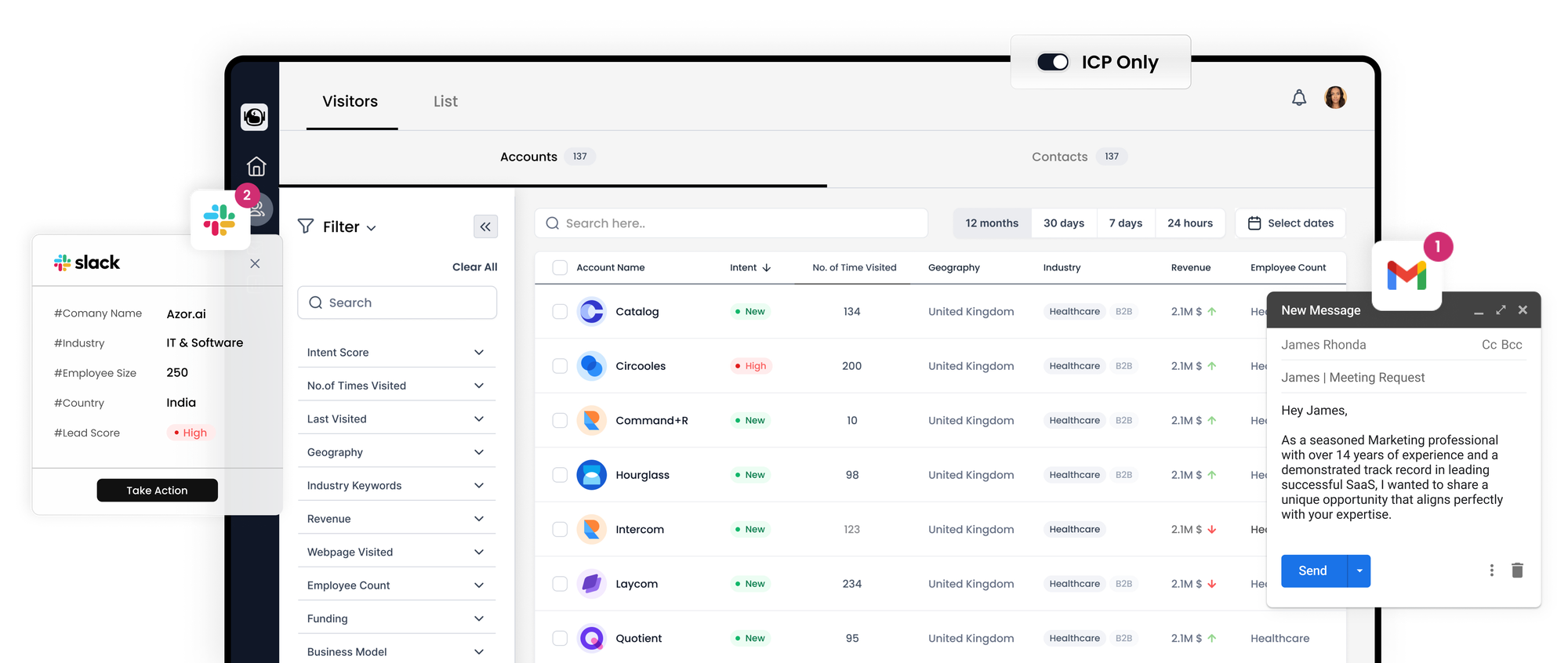What is ABM? Why should we use it?

Account-Based Marketing (ABM) is gaining momentum among B2B marketers as it integrates well with the overarching marketing objectives of driving sustainable revenue growth.

Understanding Account-Based Marketing
ABM zeroes in on a tailored set of target accounts and dedicates marketing resources to penetrate them. This method demands a tight-knit collaboration between sales and marketing teams to craft bespoke messages for each account. The goal? To boost revenue within a compressed time frame.
Rather than broad-spectrum lead generation, ABM proponents partner with sales to pinpoint prime prospects, creating personalized campaigns to resonate with the collective minds of the buying teams within these accounts.
The Rationale for Adopting ABM
Amid expanding buyer groups, marketing teams face intensified pressure to tangibly affect revenue growth. This is where ABM comes in, directing focus onto cultivating deeper relationships with the most lucrative and opportunity-rich accounts.
Take the example of selling a high-end SaaS platform or consultancy service; it's more strategic to target accounts with both the greatest need and budget rather than adopting a scattershot approach across various business sizes. Collaborating closely, marketing and sales can pursue and captivate these accounts more effectively, allowing the luxury of a more deliberate and engaging approach.
The level of personalization that ABM requires is becoming increasingly critical as buyers demand communications tailored to their unique business needs and personal roles within their companies.
Benefits of ABM Across the Board
While some contend that ABM is particularly potent for B2B entities with a small number of significant accounts or within a certain market segment, others maintain that it's applicable for any B2B organization targeting high-value accounts.
Sales teams have long practiced account-based approaches, and with marketing's involvement, they can finesse their personalized communication, speeding up the sales cycle and enhancing deal-closing rates for more substantial transactions.
Marketing stands to gain, too, as the alliance with sales transforms them into a strategic partner, focusing on a mutually agreed-upon list of potential targets. Studies indicate that 84% of firms practicing ABM report it returning higher ROI than other marketing initiatives. Moreover, marketing gains a richer understanding of the target audience, which can inform and amplify other marketing activities.
Customers also reap the rewards of ABM, enjoying tailored interactions and content that hit the mark, recognizing the effort put into understanding their needs, and valuing their time by not bombarding them with irrelevant material.
Aligning Sales and Marketing within ABM
The crux of ABM's success lies in the seamless integration of sales and marketing into a unified account team. Lacking this synergy could lead to disjointed customer experiences. Clear and ongoing communication is essential, setting shared goals and strategies to attract and engage the right accounts.
Setting up a Framework for ABM
When sales and marketing converge on the aim to target and win over accounts, they can craft an ABM strategy together. Developing this strategy should be a collaborative effort, with both teams operating as an 'account team' to drive targeted goals such as identifying more decision-makers, setting up high-level meetings, speeding up the sales process, improving customer loyalty, and increasing revenue within existing accounts.
Essentially, Account-Based Marketing (ABM) involves marketing directing its resources and budget towards a selection of key accounts that are most crucial from a sales perspective. Both sales and marketing teams work collaboratively to establish shared objectives, tailor messaging and content, and agree on execution tactics and metrics for measuring success. Below is an overview of the steps involved in formulating an ABM strategy.
Step 1: Pinpoint High-Value Targets
Examine your customer base to identify those who exemplify your ideal client profile. This typically includes customers who offer long-term profitability, are satisfied with your solutions, and fit well with your company's ethos, providing significant lifetime value.
Identify not just current clients open to expanding their engagement with you but also prospective accounts that meet your strategic benchmarks. When considering new accounts, evaluate if they have an immediate, addressable need that justifies a significant investment in your services or products.
Step 2: Identify the Buying Committee
Significant B2B purchases are rarely decided by one individual. It's vital to recognize and engage all stakeholders who influence the purchase decision. Establish who these influential individuals are within each target account, like a CMO or CFO, and understand how your product aligns with their strategic business goals to facilitate a consensus-driven purchase.
Step 3: Tailor Your Campaigns
Craft individualized campaigns for your target accounts and the key stakeholders within them. Successful ABM is rooted in building relationships, offering value, and guiding prospects through their purchasing cycle with personalized content and interactions that speak directly to each stakeholder’s specific needs and challenges.
Integrate thought leadership into your strategy by:
- Understanding stakeholder perspectives through research
- Presenting a well-supported viewpoint demonstrating your expertise
- Illustrating the practical value of your ideas with concrete examples
Personalizing content for each member within an account fosters trust and positions your company as a well-informed advisor.
Step 4: Select the Right Channels
Determine the most frequented channels by the key players in your target accounts for their industry-related research and problem-solving. These channels may differ based on roles or industry sectors, requiring a customized approach.
Step 5: Construct a Strategic Playbook
Draft a playbook that delineates the roles, responsibilities, and timelines, outlining specific engagement tactics for marketing and sales. Establish a cadence of communications that aligns with your strategic engagement points, matching them with the right channels and messages.
Step 6: Implement Your Campaigns
Execute targeted campaigns with a personalized touch appropriate for each contact within the accounts. Use various tactics such as personalized emails, events, or direct outreach, leveraging commonalities such as shared educational backgrounds or professional networks for more impactful connections.
Step 7: Analyze and Refine
ABM demands a different analytical approach than standard lead generation. Sales and marketing should jointly scrutinize the progression of accounts through the sales funnel rather than individual leads. Monitor engagement, track new opportunities, analyze won deals and their values, and allow ample time for these efforts to bear fruit before making necessary adjustments to your approach.
Account-Based Marketing (ABM) Varieties
ITSMA has been instrumental in pioneering ABM since the 2000s and recognizes three distinct types of ABM: strategic, lite, and programmatic.
Strategic ABM is highly personalized and focused on one-to-one relationships with individual key accounts, with custom marketing efforts designed around a deep understanding of the target account.
ABM Lite allows for ABM practices to be implemented at a larger scale, with somewhat personalized campaigns targeting clusters of accounts that share common characteristics.
Programmatic ABM leverages technology to apply elements of both strategic and lite ABM across many accounts, often targeting specific industry segments or business lines.
Depending on the company's needs and ABM maturity, a combination of these approaches might be employed.
Account-Based Marketing vs. Inbound Marketing
Marketers often deliberate on whether to invest in ABM or inbound marketing. However, these two are not mutually exclusive; they can synergistically bolster one another. While ABM involves engaging specific accounts with personalized content, inbound marketing uses valuable content to attract a broader audience, potentially uncovering ideal customers not yet identified.
For inbound efforts to succeed, especially in the B2B space, SEO is critical, and supplementing content visibility through online advertising can be very effective.
Account-Based Advertising
Account-based advertising is proactive, allowing marketers to specify which accounts see their ads. LinkedIn Account Targeting is a popular tool that matches a list of target companies with the vast number of Company Pages on LinkedIn.
By using LinkedIn's ad tools like Sponsored Content and Message Ads, marketers can reach stakeholders with content that’s relevant to their role and purchase journey stage. This is particularly useful for engaging decision-makers who may not be actively searching for your solutions.
Marketers using LinkedIn Matched Audience campaigns, for instance, have noted a significant increase in conversion rates and a decrease in cost-per-conversion.
Challenges in ABM Implementation
Some barriers that can impede ABM success include:
Misalignment on Target Accounts: If sales and marketing can't agree on target accounts, the potential of ABM cannot be fully realized.
Inconsistent Data: Using disparate data sources between marketing and sales teams can lead to a lack of synchronization in target account identification.
Unrealistic Expectations: Expecting immediate results from ABM is unrealistic; the approach usually yields gradual improvements, not overnight transformations.
ABM in Practice
Advancements in marketing tools and technology have facilitated the application of ABM. LinkedIn, for instance, offers Account Targeting to enable marketers to reach key accounts with LinkedIn Sponsored Content and Message Ads, enhancing the precision of their targeted messages.
Enhancing ABM on LinkedIn
LinkedIn not only provides Account Targeting but also partners with various platforms such as Terminus, Demandbase, Adobe, HubSpot, and more, offering additional services and integrations to elevate your ABM strategy on the platform.
